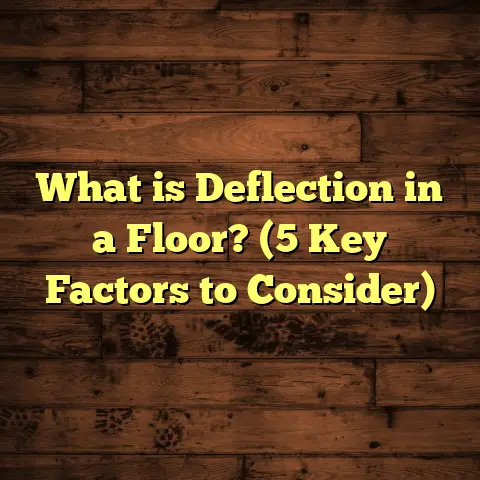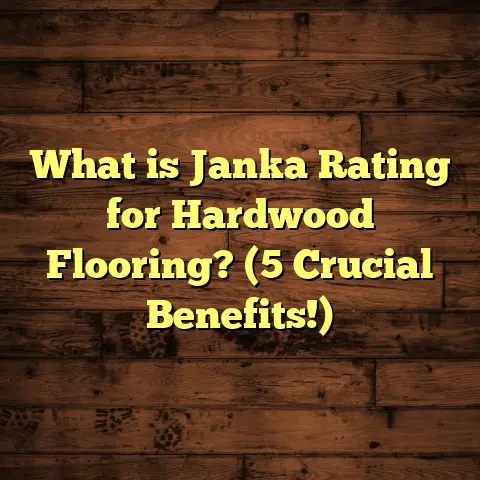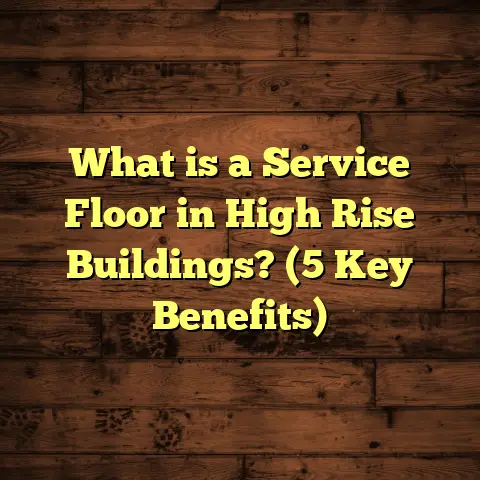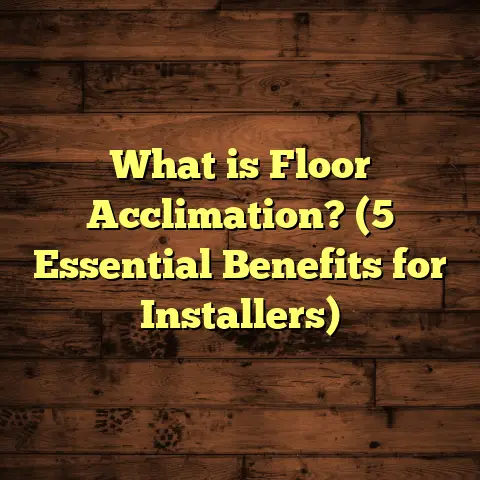What is Pressed Wood Flooring? (5 Benefits You Didn’t Know!)
Trends in flooring materials keep changing, and I’ve noticed pressed wood flooring standing out more and more lately. It’s become a go-to choice for many homeowners and contractors who want something that looks good, performs well, and doesn’t cost a fortune. But what really is pressed wood flooring? You may have heard the term but not quite understood its full story, or why it might be a better fit than solid hardwood or laminate for your space.
As someone who’s been in the flooring trade for years, I’ve installed and lived with pressed wood floors in various projects. I want to share what I’ve learned—both from the job site and research—to help you decide if pressed wood flooring deserves a spot in your home or business.
What is Pressed Wood Flooring?
Pressed wood flooring is a type of engineered wood floor made by compressing layers of wood fibers or veneers with adhesives under heat and pressure. These layers form planks or panels that look like solid wood but have enhanced stability and often a lower price tag.
How It’s Made
Pressed wood starts with thin slices or fibers of wood. These are layered with glue and pressed tightly together:
- The top layer is a real wood veneer. This veneer can be from oak, maple, cherry, walnut—you name it.
- Beneath that are several core layers made from plywood or fiberboard like HDF (high-density fiberboard) or MDF (medium-density fiberboard).
- The layers run perpendicular to each other to add strength.
- The entire plank is pressed under high pressure and heat to cure the adhesive and bind the layers into a solid piece.
The result looks similar to solid hardwood but behaves differently because of the layered structure.
Why Pressed Wood?
Solid hardwood comes from one thick piece of lumber, which can expand, contract, warp, or cup based on moisture levels. Pressed wood’s multi-layer design counters these problems by balancing the forces internally.
This means pressed wood floors tend to stay flatter and more stable under changing humidity or temperature. For places like basements, kitchens, or even regions with wide seasonal changes, this stability is a big advantage.
My First Encounter
The first time I worked extensively with pressed wood was around eight years ago. A homeowner wanted the warmth and elegance of oak floors but couldn’t justify the cost of solid hardwood. After discussing pros and cons, we went with a pressed wood floor with a thick oak veneer.
I’ll admit I was a bit skeptical at first. Would it last? Would it look cheap? But after installation, my doubts vanished. The floor looked authentic, felt sturdy underfoot, and held up well over months of use. That project opened my eyes to the potential of pressed wood flooring beyond just budget options.
Getting to Know Pressed Wood Flooring Through Its Benefits
I want to walk you through some benefits I’ve seen firsthand—features that often go unnoticed or underestimated when people choose flooring materials.
1. Impressive Stability Against Moisture
This is probably the biggest technical advantage pressed wood has over solid hardwood. Have you ever noticed cracks or gaps forming in your hardwood floors during dry winters? Or boards swelling in humid summers?
Pressed wood’s layered core acts like a counterbalance. The grain directions in different layers resist expansion and contraction forces. According to the Hardwood Plywood & Veneer Association (HPVA), engineered or pressed wood floors experience about 50% less movement than solid hardwood.
I have worked on multiple projects where solid hardwood floors started showing gaps between boards after a year or two due to moisture changes. Meanwhile, the pressed wood floors in the same environment remained tight and flat.
This means less repair work over time and fewer worries about seasonal damage.
2. Affordable Elegance
Pressed wood floors let you enjoy the look of real hardwood at a lower cost. Here’s a breakdown from some recent market data:
| Flooring Type | Average Cost per Sq Ft (Materials Only) |
|---|---|
| Solid Oak Hardwood | $8 – $15 |
| Pressed Wood with Oak Veneer | $4 – $8 |
| Laminate Flooring | $2 – $5 |
Prices vary by quality and region, but you get the idea: pressed wood can cut material costs by nearly half compared to solid hardwood.
On one of my kitchen remodels, the client wanted walnut floors but had a limited budget. We chose pressed walnut veneer flooring instead of solid walnut planks. This saved them roughly 35% on their flooring budget while delivering that rich look they desired.
3. An Eco-Friendly Flooring Choice
Pressed wood flooring uses resources more efficiently than solid hardwood floors. Because manufacturers slice veneers thinly and use fast-growing species for core layers like plywood or fiberboard, less mature forest land is impacted.
The Forest Stewardship Council (FSC) certifies many engineered wood products as responsibly sourced. Plus, many pressed wood floors use low-VOC adhesives, which improves indoor air quality—a factor many modern homeowners care deeply about.
From my conversations with suppliers, there’s also less waste in manufacturing since smaller offcuts can be repurposed for cores rather than discarded.
In fact, life-cycle studies show that engineered wood uses about 40% less raw material per square foot installed than traditional hardwood floors.
4. Quicker and Easier Installation
Installation speed matters when you’re managing timelines or trying to reduce labor costs. Pressed wood flooring’s dimensionally stable planks are often designed with user-friendly locking systems—like click-lock edges—that snap together without nails or glue.
In one commercial office project I worked on recently, our team installed over 1,200 square feet of pressed wood flooring in just four days—significantly faster than if we had used traditional hardwood that requires nailing down and acclimatization periods.
Because pressed wood doesn’t warp as easily during installation, there’s less fussing with uneven boards or peaking seams.
5. Versatility and Variety
You might think pressed wood floors only come in basic styles, but the variety is impressive:
- Different woods: oak, maple, hickory, cherry, walnut.
- Diverse finishes: matte, semi-gloss, hand-scraped textures.
- Exotic woods that would be pricey as solid planks are more affordable as veneers.
- Wide plank widths or traditional narrow strips.
- Colors ranging from natural light tones to deep espresso hues.
One homeowner of mine wanted a rustic farmhouse look with distressed hickory veneer floors. We found exactly what she needed in a pressed wood product line that mimicked aged hardwood beautifully without the cost or fragility of reclaimed timber.
Understanding Pressed Wood Flooring in Real Life: Data Points and Stats
I dug into some recent studies and market data to give you perspective on pressing trends and performance:
- The global market for engineered wood flooring is expected to grow at roughly 6.5% annually through 2027 (source: Grand View Research).
- Consumer surveys by Houzz in 2023 showed over 30% of new floor installations were engineered/pressed wood versus just 20% for solid hardwood.
- Life-cycle assessments indicate engineered products reduce raw material consumption by up to 40% compared to solid lumber.
- According to the National Wood Flooring Association (NWFA), pressed wood floors typically have warranties ranging from 25 years to lifetime depending on wear layer thickness.
- The average lifespan of well-maintained pressed wood flooring ranges from 20 to 40 years—close to solid hardwood durability under normal conditions.
These numbers back up what I’ve witnessed onsite: increasing popularity driven by value and performance.
A Case Study From My Flooring Projects
Let me tell you about a renovation job that really highlighted the benefits of pressed wood flooring:
The house was built in the 1920s with original hardwood floors that were damaged beyond repair after decades of wear and water damage. The owners wanted to keep the vintage style but needed something more resilient.
We selected a high-grade pressed wood floor with a thick oak veneer layer finished with matte polyurethane to maintain an authentic look without glossiness.
Two years later:
- The owners reported zero issues with warping or cupping despite seasonal humidity swings.
- The floor showed minor scratches easily buffed out.
- Installation took just five days.
- Total costs stayed within budget thanks to choosing pressed wood over expensive specialty hardwoods.
This project proved that pressed wood flooring can be both beautiful and practical for historic homes needing modern durability.
Cost Estimation Tips From My Experience
One challenge I often face is giving clients accurate cost estimates for flooring projects. There are so many factors: material type, labor rates, waste percentages, subfloor prep… it can get confusing fast.
I now rely heavily on tools like FloorTally for this. It allows me to:
- Input exact room dimensions.
- Choose from various materials including different pressed wood options.
- Add labor rates based on my local market.
- Factor in waste percentages so there are no surprises.
- Visualize total projected costs in one place.
This helps me avoid guesswork and gives clients a clear budget roadmap upfront—saving time and building trust.
Have you ever struggled comparing prices from different suppliers? Tools like FloorTally take much of that hassle away by consolidating data instantly.
How Pressed Wood Compares With Other Engineered Floors
Sometimes people confuse pressed wood with laminate or other engineered options. Here’s how they differ:
| Feature | Pressed Wood Flooring | Laminate Flooring | Solid Hardwood |
|---|---|---|---|
| Surface Layer | Real hardwood veneer | Photographic image + protective coat | Solid timber |
| Core | Plywood/HDF/MDF layered | High-density fiberboard | Single piece of lumber |
| Moisture Resistance | Good – stable under humidity changes | Poor – swells if wet | Poor – expands/contracts |
| Installation | Click-lock/tongue & groove | Click-lock | Nail/glue down |
| Cost | Moderate | Low | High |
| Appearance | Authentic hardwood look | Imitation | Authentic |
| Repairability | Can be sanded/refinished (limited times) | Cannot refinish | Can be sanded many times |
Pressed wood flooring hits a sweet spot by offering an authentic look combined with better moisture resistance than laminate while costing less than solid hardwood.
Maintenance Tips for Pressed Wood Floors
Keeping your pressed wood floor looking great isn’t complicated but does require some care:
- Sweep/vacuum regularly to remove grit that can cause scratches.
- Avoid harsh chemicals; stick to manufacturer-recommended cleaners.
- Wipe spills immediately; don’t let water sit on the surface.
- Use felt pads under furniture legs to prevent dents.
- Mop occasionally with a damp cloth—not soaking wet.
- Avoid high heels or pet nails digging into surface finishes.
If you treat your floor right, it will stay beautiful for many years—and its stability means fewer surprises like gaps or warping compared to solid hardwood.
Common Questions About Pressed Wood Flooring
Q: Can pressed wood floors be refinished?
A: Yes, but only a few times depending on veneer thickness (usually between 2mm and 6mm). Thicker veneers allow more refinishing cycles; thinner ones might only handle one lightly sanding before replacement is needed.
Q: Are pressed wood floors noisy?
A: They can sometimes be louder than carpet but quieter than laminate due to their dense core layers. Proper underlayment helps reduce noise significantly.
Q: How long do they last?
A: With proper maintenance, expect 20–40 years lifespan—comparable to many hardwoods under normal use.
Q: Are they suitable for bathrooms?
A: Generally no. Even though they resist moisture better than solid hardwood, direct exposure to standing water can still damage them over time.
Q: Can I install over radiant heating?
A: Yes! Pressed wood flooring works well over radiant heat systems due to its stable construction.
Final Thoughts From My Flooring Journey
Pressed wood flooring has proven itself as more than just an affordable alternative—it’s become a reliable choice balancing beauty, durability, eco-consciousness, and ease of installation. Over years working with clients from all walks of life—homeowners wanting affordable style or business owners seeking durability—I’ve witnessed this material earn its place in modern flooring options.
If you’re pondering your next flooring project and want something that offers real wood aesthetics with fewer headaches than solid hardwood, give pressed wood flooring serious thought. And if you want help figuring out costs or options tailored for your space, I’m here to share what I’ve learned along the way—including how tech tools like FloorTally can simplify planning and budgeting so you don’t get overwhelmed sorting through quotes and specs yourself.
Do you already have pressed wood floors? Or thinking about making the switch? Let me know if you want tips specific to your home or project—I’d love to help!





